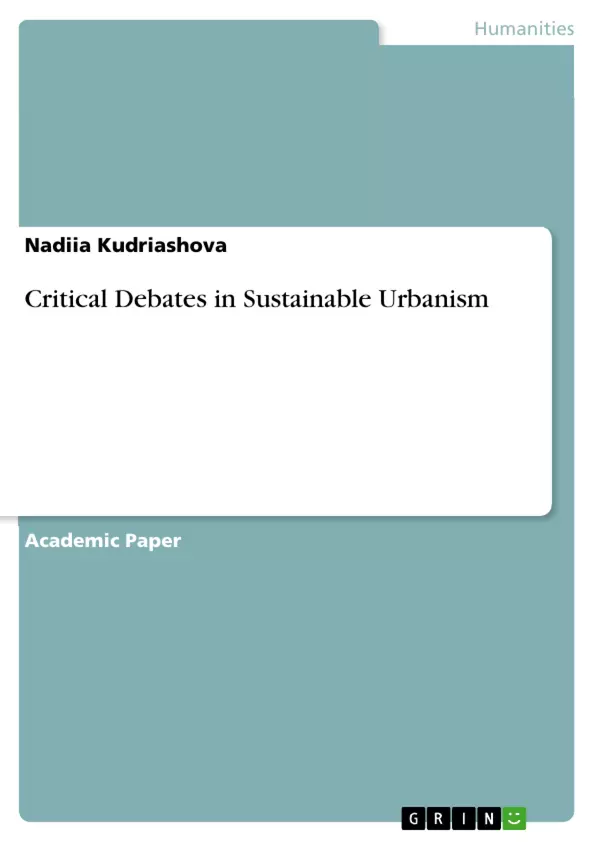The processes of globalization, taking place at the present stage of social development, have led to profound social changes. Institutes and values, stereotypes of economic and social behavior of different population groups are changing. Qualitative changes in social conditions had an impact primarily on socio-economic processes in cities, on the rhythm, style, and lifestyle of the urban population. Economic, social, and political transformations in modern society have received the most pronounced territorial dimension, affecting primarily the cities that are the locomotives of these transformations.
In the US, historically developed cities have a clear and compact layout, a mixed character of building-up due to the geographical, transport, and economic factors of the time. However, in the last sixty years, a completely different model of development has appeared. Cities began to grow along the highways and around urban and rural centers due to the appearance of a large number of private cars, cheap fuel, inexpensive land and growing prosperity. Housing construction with low population density began to threaten agricultural lands and damage open spaces, raise public services costs, and encourage people to leave large cities. All this has led to traffic jams on the roads, degradation of environmental and quality of life. Such a model of settlement could arise due to the current town-planning norms of zoning of the territory, which separates residential development from workplaces, shops, and schools. These norms put car drivers in a predominant position in relation to pedestrians.
Inhaltsverzeichnis (Table of Contents)
- Critical Debates in Sustainable Urbanism
- The Concept of Sustainable Urbanism
- The Challenges of Sprawl and the Rise of Sustainable Urbanism
- Defining Sustainable Urbanism: A Multifaceted Approach
- Research on Sustainable Urbanism: Policy, Planning and Practice
- New Urbanism: Restoring the City's Social Role
Zielsetzung und Themenschwerpunkte (Objectives and Key Themes)
This text explores the concept of sustainable urbanism and its implications for city planning and development. It examines the historical context of urban sprawl, analyzes the key principles and practices of sustainable urbanism, and discusses the role of policy and planning in achieving sustainable urban development. The text emphasizes the need for integrated approaches that consider social, economic, and environmental aspects of urban environments.
- The challenges of urban sprawl and its negative impact on the environment, social life, and the economy
- The concept of sustainable urbanism as a response to the challenges of sprawl
- The diverse definitions and approaches to sustainable urbanism
- The role of policy and planning in promoting sustainable urban development
- The principles of New Urbanism and its focus on creating walkable, pedestrian-friendly communities
Zusammenfassung der Kapitel (Chapter Summaries)
- This chapter introduces the concept of sustainable urbanism and its historical context, focusing on the challenges of urban sprawl and its detrimental effects on the environment, social life, and the economy. It argues that sustainable urbanism emerged as a response to the unsustainable practices of the past.
- This chapter explores the various definitions and approaches to sustainable urbanism, highlighting its multi-faceted nature. It examines different perspectives on what constitutes a sustainable city, from ecological considerations to social and economic aspects.
- This chapter delves into research on sustainable urbanism, exploring how various actors, including policy-makers, planners, and practitioners, are addressing the challenges of urban development. It examines different approaches to integrating sustainability principles into urban policies and plans.
- This chapter focuses on the New Urbanism movement and its principles. It emphasizes the importance of creating walkable, pedestrian-friendly communities, promoting mixed-use development, and reducing reliance on automobiles. The chapter discusses the potential of New Urbanism to revitalize urban spaces and foster social connections.
Schlüsselwörter (Keywords)
Sustainable urbanism, urban sprawl, new urbanism, smart growth, ecocity, urban planning, policy, governance, social sustainability, environmental sustainability, economic sustainability, walkability, mixed-use development, pedestrian-friendly communities, urban design.
- Quote paper
- Nadiia Kudriashova (Author), 2017, Critical Debates in Sustainable Urbanism, Munich, GRIN Verlag, https://www.grin.com/document/463171



